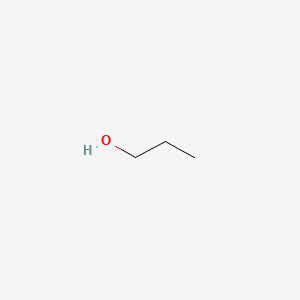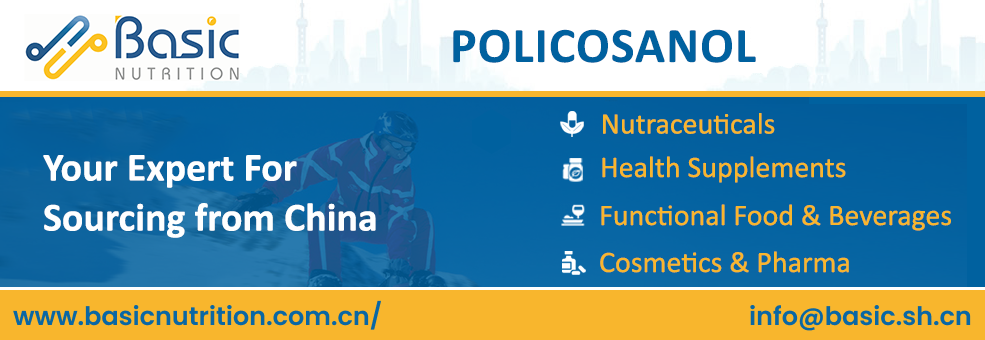



1. Alcohol, Propyl
2. N-propanol
3. Propanol
4. Propyl Alcohol
1. Propanol
2. Propan-1-ol
3. Propyl Alcohol
4. N-propanol
5. 71-23-8
6. N-propyl Alcohol
7. Ethylcarbinol
8. 1-hydroxypropane
9. Optal
10. Policosanol
11. Osmosol Extra
12. Propylic Alcohol
13. Propanol-1
14. 1-propyl Alcohol
15. N-propan-1-ol
16. Propanolen
17. Propanole
18. Alcohol, Propyl
19. Propanoli
20. Ethyl Carbinol
21. Alcool Propilico
22. Alcool Propylique
23. N-propyl Alkohol
24. Propylowy Alkohol
25. 1-proponol
26. Propane-1-ol
27. 142583-61-7
28. Propylalcohol
29. Fema No. 2928
30. Nsc 30300
31. N-proh
32. Propylan-propyl Alcohol
33. Mfcd00002941
34. Chebi:28831
35. 96f264o9sv
36. Nsc-30300
37. Un 1274
38. 1-propanol, Anhydrous
39. Albacol
40. Pol
41. Propanole [german]
42. Propanolen [dutch]
43. Propanol, 1-
44. Propanoli [italian]
45. Propyl Alcohol, Normal
46. Caswell No. 709a
47. Fema Number 2928
48. Propyl Alcohol (natural)
49. 1 Propanol
50. Alcool Propilico [italian]
51. Alcool Propylique [french]
52. N-propyl Alkohol [german]
53. Propylowy Alkohol [polish]
54. Propyl Alcohol, N-
55. Ccris 3202
56. Hsdb 115
57. Einecs 200-746-9
58. Un1274
59. Epa Pesticide Chemical Code 047502
60. Brn 1098242
61. Hydroxypropane
62. Ethyl Methanol
63. N-propylalcohol
64. Normal Propanol
65. N-propylalkohol
66. Unii-96f264o9sv
67. Ai3-16115
68. 62309-51-7
69. 3-propanol
70. Nproh
71. Hopr
72. Proh
73. Normal Propyl Alcohol
74. N-propanol Acs Grade
75. N-c3h7oh
76. 1-propanol, Hplc Grade
77. Dsstox_cid_1739
78. Bmse000446
79. N-propanol [hsdb]
80. Propanol [who-dd]
81. 1-propanol, >=99%
82. Ec 200-746-9
83. Dsstox_rid_76299
84. Propyl Alcohol [mi]
85. Dsstox_gsid_21739
86. Propyl Alcohol [fcc]
87. Wln: Q3
88. 4-01-00-01413 (beilstein Handbook Reference)
89. Chembl14687
90. Propyl Alcohol [fhfi]
91. Propyl Alcohol [inci]
92. 1-propanol [usp-rs]
93. 1-propanol, Analytical Standard
94. 1-propanol, Jis Special Grade
95. Propanol [ep Monograph]
96. Propyl Alcohol [mart.]
97. 1-propanol, >=99%, Fg
98. 1-propanol, Lr, >=99%
99. Dtxsid2021739
100. 1-propanol, >=99.80%
101. Bdbm36153
102. Propyl Alcohol (fragrance Grade)
103. Propyl Alcohol (propanol)
104. 1-propanol, Anhydrous, 99.7%
105. 1-propanol, P.a., 99.5%
106. Zinc895969
107. 1-propanol, Ar, >=99.5%
108. Amy11110
109. Nsc30300
110. Tox21_302440
111. 1-propanol, Spectrophotometric Grade
112. Lmfa05000101
113. N-propanol Or Propyl Alcohol, Normal
114. Stl264225
115. 1-propanol, Natural, >=98%, Fg
116. Hydroxypropyl Cellulose-sl (hpc-sl)
117. 1-propanol 1000 Microg/ml In Water
118. 1-propanol, >=99% (gc), Purum
119. Akos000249219
120. 1-propanol, For Hplc, >=99.5%
121. 1-propanol, For Hplc, >=99.9%
122. Db03175
123. 1-propanol, Acs Reagent, >=99.5%
124. 1-propanol, Hplc Grade, >=99.5%
125. Cas-71-23-8
126. 1-propanol 1000 Microg/ml In Methanol
127. 1-propanol, Purum, >=99.0% (gc)
128. Ncgc00255163-01
129. 1-propanol 100 Microg/ml In Acetonitrile
130. 1-propanol, Saj First Grade, >=99.0%
131. Propyl Alcohol (normal) Reagent Grade Acs
132. Ft-0608280
133. Ft-0608281
134. Ft-0627482
135. P0491
136. 1-propanol, Uv Hplc Spectroscopic, 99.0%
137. C05979
138. Q14985
139. A837125
140. J-505102
141. 1-propanol, For Inorganic Trace Analysis, >=99.8%
142. 1-propanol, B&j Brand (product Of Burdick & Jackson)
143. F0001-1829
144. Z955123580
145. 1-propanol, Puriss. P.a., Reag. Ph. Eur., >=99.5% (gc)
146. 1-propanol, United States Pharmacopeia (usp) Reference Standard
147. N-propanol Or Propyl Alcohol, Normal [un1274] [flammable Liquid]
148. 1-propanol, Pharmaceutical Secondary Standard; Certified Reference Material
149. 5vq
150. 71-31-8
| Molecular Weight | 60.10 g/mol |
|---|---|
| Molecular Formula | C3H8O |
| XLogP3 | 0.3 |
| Hydrogen Bond Donor Count | 1 |
| Hydrogen Bond Acceptor Count | 1 |
| Rotatable Bond Count | 1 |
| Exact Mass | 60.057514874 g/mol |
| Monoisotopic Mass | 60.057514874 g/mol |
| Topological Polar Surface Area | 20.2 Ų |
| Heavy Atom Count | 4 |
| Formal Charge | 0 |
| Complexity | 7.2 |
| Isotope Atom Count | 0 |
| Defined Atom Stereocenter Count | 0 |
| Undefined Atom Stereocenter Count | 0 |
| Defined Bond Stereocenter Count | 0 |
| Undefined Bond Stereocenter Count | 0 |
| Covalently Bonded Unit Count | 1 |
D08AX03
S76 | LUXPHARMA | Pharmaceuticals Marketed in Luxembourg | Pharmaceuticals marketed in Luxembourg, as published by d'Gesondheetskeess (CNS, la caisse nationale de sante, www.cns.lu), mapped by name to structures using CompTox by R. Singh et al. (in prep.). List downloaded from https://cns.public.lu/en/legislations/textes-coordonnes/liste-med-comm.html. Dataset DOI:10.5281/zenodo.4587355
C - Cardiovascular system
C10 - Lipid modifying agents
C10A - Lipid modifying agents, plain
C10AX - Other lipid modifying agents
C10AX08 - Policosanol
D - Dermatologicals
D08 - Antiseptics and disinfectants
D08A - Antiseptics and disinfectants
D08AX - Other antiseptics and disinfectants
D08AX03 - Propanol
PROPANOL-1 IS ABSORBED FROM GI TRACT & LUNGS. IT CAN BE ABSORBED FROM THE SKIN IF A SIGNIFICANT AMOUNT IS CONFINED TO THE SKIN. 1-PROPANOL IS ABSORBED MORE READILY THAN ETHANOL. ...
Snyder, R. (ed.). Ethel Browning's Toxicity and Metabolism of Industrial Solvents. Second Edition. Volume 3 Alcohols and Esters. New York, NY: Elsevier, 1992., p. 28
... USING ABDOMINAL AUTOPSY /HUMAN/ SKIN IN A DIFFUSION CHAMBER ... 1-PROPANOL PENETRATED THE SKIN MORE RAPIDLY FROM SOLUTION IN NONPOLAR SOLVENTS SUCH AS ISOPROPYL PALMITATE, OLIVE OIL, & MINERAL OIL THAN FROM SOLUTION IN SALINE.
Clayton, G. D. and F. E. Clayton (eds.). Patty's Industrial Hygiene and Toxicology: Volume 2A, 2B, 2C: Toxicology. 3rd ed. New York: John Wiley Sons, 1981-1982., p. 4561
FOLLOWING AN ORAL DOSE OF 2 G/KG TO RATS, 0.13% OF THE DOSE WAS EXCRETED IN THE URINE. ... 1.65% /WAS/ EXCRETED IN THE EXPIRED AIR & 0.7% EXCRETED IN THE URINE FOLLOWING AN ORAL DOSE OF 2 ML/KG TO RABBITS.
Clayton, G. D. and F. E. Clayton (eds.). Patty's Industrial Hygiene and Toxicology: Volume 2A, 2B, 2C: Toxicology. 3rd ed. New York: John Wiley Sons, 1981-1982., p. 4560
Urine was analyzed immediately, 1, 2, 8, and 9 hr after drinking (during 2 hr) 3.75 ml/kg of beverages containing orange juice, 15 or 40% ethanol, and and 1 g/l of 1-propanol, 2-propanol, 1-butanol, 2-butanol, isobutyl alcohol or a mixture of 1-propanol & isobutyl alcohol. Maximum urine levels /in mg/l/ were found 1 hr after drinking ended: 1-propanol 5.04, 2-propanol 3.36, 1-butanol 0.43, 2-butanol 2.55, isobutyl alcohol ... 1.7-2.03 mg/l. Urine treatment with beta-glucuronidase before analysis indicated that significant amounts of the alcohols were excreted as glucuronides, esp isobutyl alcohol. 2-Propanol and 2-butanol were the slowest to be metabolized. When mixtures of alcohols were given, the concentrations of isobutyl alcohol glucuronides were high with the mixtures containing 5 and 15% ethanol, and decreased at 40% ethanol.
Bonte W et al; Blutalkohol 18 (6): 412-26 (1981)
... PROPANOL ... MAY FORM ETHEREAL ... /SULFATE/
LaDu, B.N., H.G. Mandel, and E.L. Way. Fundamentals of Drug Metabolism and Disposition. Baltimore: Williams and Wilkins, 1971., p. 161
1-PROPANOL IS METABOLIZED BY THE ENZYME ALCOHOL DEHYDROGENASE. IT IS READILY OXIDIZED IN THE BODY, FIRST TO PROPIONIC ACID AND THEN TO CARBON DIOXIDE, WATER AND PERHAPS A SMALL AMOUNT OF LACTIC ACID.
Snyder, R. (ed.). Ethel Browning's Toxicity and Metabolism of Industrial Solvents. Second Edition. Volume 3 Alcohols and Esters. New York, NY: Elsevier, 1992., p. 27
... HEPATIC MICROSOMES CATALYZED THE OXIDATION OF PROPANOL TO ITS ALDEHYDE IN THE RAT. THE REACTION REQUIRED OXYGEN & NICOTINAMIDE-ADENINE DINUCLEOTIDE PHOSPHATE, WAS INHIBITED BY CARBON DIOXIDE AND ACTED INDEPENDENTLY OF CATALASE & ALCOHOL DEHYDROGENASE.
Clayton, G. D. and F. E. Clayton (eds.). Patty's Industrial Hygiene and Toxicology: Volume 2A, 2B, 2C: Toxicology. 3rd ed. New York: John Wiley Sons, 1981-1982., p. 4560
Cytochrome p450 isozyme 3a, isolated from hepatic microsomes of rabbits treated chronically with ethyl alcohol, had a unique substrate specificity when compared with isozymes 2, 3b, 3c, and 4. Form 3a has unusually high activity in the p-hydroxylation of aniline and in the oxidation of alcohols to aldehydes. Isozyme 3a catalyzes the oxidation of methyl alcohol, propyl alcohol, and butanol as well as ethyl alcohol.
PMID:7142188 Morgan ET et al; J Biol Chem 257 (23): 13951-7 (1982)
For more Metabolism/Metabolites (Complete) data for N-PROPANOL (6 total), please visit the HSDB record page.
No reports found; [TDR, p. 1052]
TDR - Ryan RP, Terry CE, Leffingwell SS (eds). Toxicology Desk Reference: The Toxic Exposure and Medical Monitoring Index, 5th Ed. Washington DC: Taylor & Francis, 1999., p. 1052
